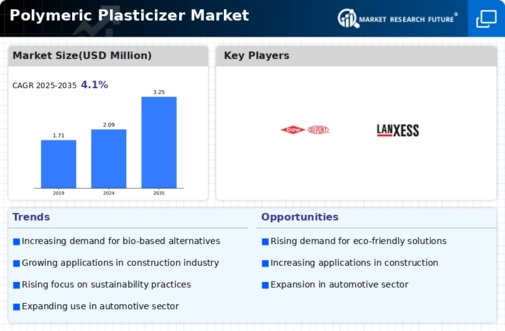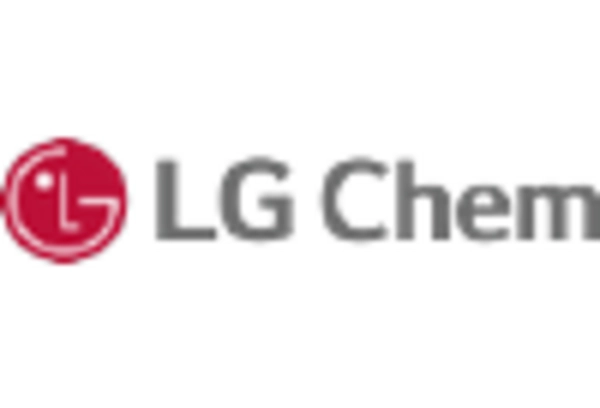Growth in End-Use Industries
The expansion of end-use industries such as automotive, construction, and consumer goods is a significant driver for the Polymeric Plasticizer Market. As these sectors continue to grow, the demand for polymeric plasticizers is expected to rise correspondingly. For instance, the automotive industry is increasingly utilizing polymeric plasticizers to enhance the flexibility and durability of interior components. Similarly, the construction sector is adopting these materials for their ability to improve the performance of various building products. Market data indicates that the construction industry alone is projected to witness a growth rate of approximately 5% annually, further fueling the demand for polymeric plasticizers. This trend suggests a robust future for the market as it aligns with the evolving needs of diverse industries.
Increased Regulatory Pressure
The Polymeric Plasticizer Market is experiencing increased regulatory pressure aimed at reducing the environmental impact of chemical products. Governments and regulatory bodies are implementing stricter guidelines regarding the use of phthalates and other harmful substances in plasticizers. This shift is prompting manufacturers to seek alternative solutions, such as non-toxic and bio-based plasticizers, which are becoming more prevalent in the market. The demand for safer and more sustainable plasticizers is expected to rise, as consumers and industries alike prioritize health and environmental considerations. As a result, companies that adapt to these regulatory changes by innovating their product lines are likely to gain a competitive edge in the polymeric plasticizer market.
Rising Demand for Flexible Materials
The increasing demand for flexible materials across various industries is a primary driver for the Polymeric Plasticizer Market. Flexible materials are essential in applications such as packaging, automotive, and construction, where durability and adaptability are crucial. The market for flexible PVC, which heavily relies on polymeric plasticizers, is projected to grow significantly, with estimates suggesting a compound annual growth rate of around 4.5% over the next few years. This growth is largely attributed to the rising consumer preference for lightweight and flexible products, which enhances the performance and usability of end products. As industries continue to innovate and seek materials that offer both flexibility and strength, the demand for polymeric plasticizers is likely to increase, thereby propelling the market forward.
Advancements in Production Technologies
Technological advancements in the production of polymeric plasticizers are contributing to the growth of the Polymeric Plasticizer Market. Innovations in manufacturing processes, such as the development of bio-based plasticizers, are gaining traction due to their environmental benefits. These advancements not only improve the efficiency of production but also enhance the performance characteristics of plasticizers, making them more appealing to manufacturers. For instance, the introduction of new formulations that provide better compatibility with various polymers is expected to drive market growth. Furthermore, the ability to produce plasticizers that meet stringent regulatory standards without compromising performance is likely to attract more players to the market, thereby expanding the overall industry landscape.
Consumer Preference for Eco-Friendly Products
The growing consumer preference for eco-friendly products is significantly influencing the Polymeric Plasticizer Market. As awareness of environmental issues increases, consumers are actively seeking products that are sustainable and non-toxic. This shift in consumer behavior is prompting manufacturers to innovate and develop eco-friendly polymeric plasticizers that align with these preferences. Market Research Future indicates that the demand for bio-based plasticizers is on the rise, with projections suggesting a substantial increase in market share over the next few years. Companies that prioritize sustainability in their product offerings are likely to attract environmentally conscious consumers, thereby enhancing their market position. This trend not only supports the growth of the polymeric plasticizer market but also encourages a broader shift towards sustainable practices across various industries.

















Leave a Comment